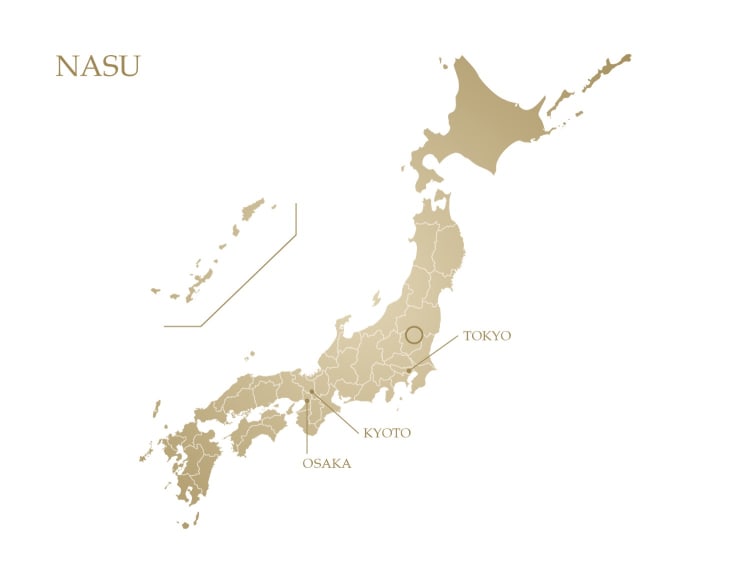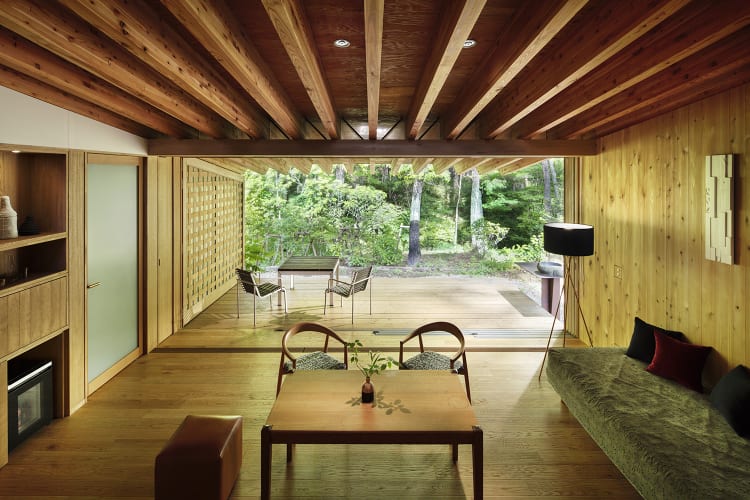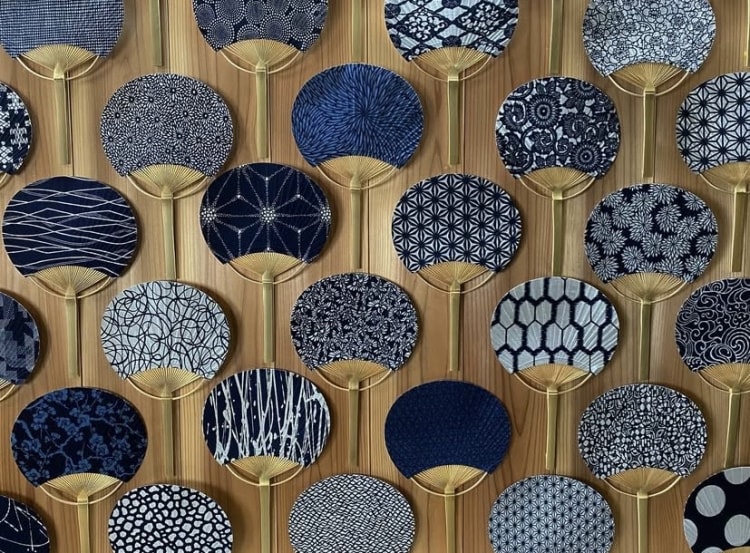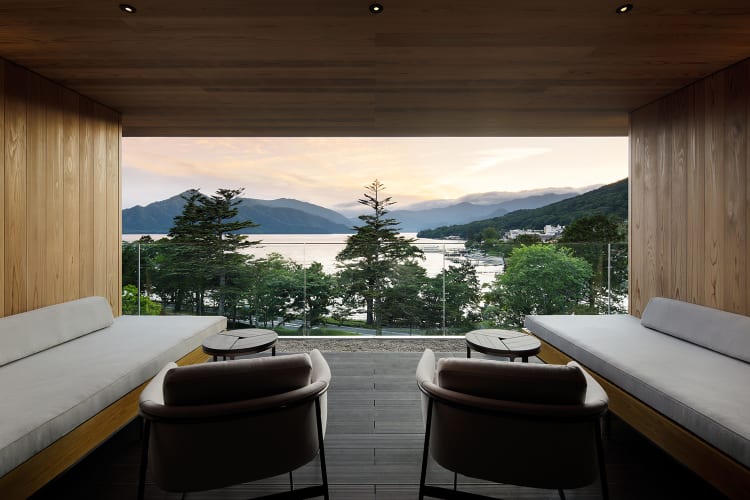Nasu: Woodland Walks, Hot-Spring Soaks, and Epicurean Delights in a Destination That’s Host to an Imperial Villa
One of Japan’s premier inland resorts, the Nasu area in northeastern Tochigi prefecture slopes gently southeast from the landmark Mt. Chausu (1,915 m) and other peaks of the Nasu mountain range to the Naka River basin known as Nasunogahara. As the place where the Kanto region of central Honshu gives way to northeastern Tohoku, Nasu has been a gateway for travelers since olden times. Magma layers running beneath Mt. Chausu, Tochigi’s only active volcano, are the thermal source of robust hot springs that have been sought after since they were first recorded in the eighth century. Moreover, since the completion of the Nasu Imperial Villa in 1926, Nasu has been a favored place of rest and recuperation for Japan’s imperial family. Their love of its serene woodlands and diverse flora and fauna has inspired both their poetry and scholarly study.


Because Nasu is situated where the alluvial plains of Nasunogahara meet the southern tail end of Japan’s longest mountain range, it is also a cornucopia of foods straight from the fields and forest. Fresh Guernsey milk and cream, and artisanal cheeses, too, are produced in rolling pasturelands that are the legacy of estate farms created by the nobility in the late nineteenth and early twentieth centuries. These connections, and its century-long history as the site of an imperial holiday villa, have given rise to a sophisticated gastronomic culture in Nasu, with many high-end accommodations and fine-dining venues to choose from. Hikers, cyclists, golfers, and strollers alike will find deep relaxation in the fragrant forests, healing hot springs, and refined cultural offerings here. The springs and aquifers of the Nasu mountain range and the Naka River basin lend themselves to the production of delicious sake, as well. Nasu is about four-fifths as big as London, and about half the size of Rhode Island. Parts of it fall within the jurisdiction of Nikko National Park.
Nature Immersion
Through the imperial family’s own research and scholarly patronage, volumes of valuable data have been produced on thousands of species of flora and fauna in Nasu, including those whose status was Vulnerable or Near Threatened. Preserving this biodiversity for the future is an important mission of Nasu today. Nearly half of the imperial villa’s land was granted to the Ministry of the Environment in 2008 by then-reigning Emperor Akihito. Now administered by Nikko National Park, this vast 560-hectare property opened to the public in 2011 as Nasu Heisei-no-mori Forest, a place dedicated to the enjoyment and deeper understanding of woodland ecology.

Nasu Heisei-no-mori Forest
The Field Center has exhibits about the site and is the gateway to the forest’s two zones: one centered on recreation, with three loop trails accommodating various ages and fitness levels; the other on learning and research, where access is restricted to guided tours led by specialists. In winter, guided snowshoe walks are offered in the recreational zone. Until the mid-1920s, the study zone had been used for logging and as pasture for horses, but under the stewardship of the Imperial Household it began to return to its natural forested state. As a dedicated nature reserve, this young forest continues to thrive today. Those involved in its care hope that someday this part of Heisei-no-mori will count among the most unspoiled and biodiverse ecosystems in the world.
Both the agricultural heritage of Nasu and its famed thermal waters can be enjoyed as though you were staying at a private villa of your own. The auberge-style nasu mukunone transforms garden- and farm-fresh ingredients into contemporary French cuisine, and offers stand-alone suites designed to make you feel at one with nature. Not to be missed is the hotel’s bespoke water garden by architect Junya Ishigami. Bettei KAI, located close-by the imperial villa, welcomes travelers with serene suites that exude Japanese elegance. No matter where you stay or dine, complement your meals with a fine sake like the Daina label brewed by Kikunosato Shuzo using Nasu-grown rice and natural aquifers of the Naka River basin.

nasu mukunone
Crafts to Love
For mementoes of your time in northeastern Tochigi, pick up handcrafted items that preserve time-honored skills in new and relevant ways. In Otawara, visit the Kurobane Aizome studio of Onuma Yuta, an eighth-generation indigo dyer who uses the hand-cut stencil, tie-dye, and other traditional methods of his trade to create one-of-a-kind contemporary accents for your wardrobe and home décor. While a number of esteemed bamboo artisans have hailed from Tochigi, you will find practical items, too, for everyday use. In Nasu look for ikebana baskets, sieves, and other stylish tools woven of Shino bamboo. And no matter what style of pottery you favor, chances are you will find much to love in Mashiko, where the kilns, in operation since 1853, first came to wide renown through the Mingei (Folk Crafts) movement. Take a class with a potter, or time your visit for the village-wide spring and fall pottery fairs typically held in the first days of May and November.

Kurobane Aizome studio
Deepen Your Journey
No stay in Tochigi is complete without a visit to Nikko. Just southwest of Nasu, it, too, has drawn pilgrims and travelers since the eighth century, when ascetic monks sought spiritual enlightenment amid its peaks, waterfalls, and gorges. The religious sanctuaries they founded received the patronage of emperors and shoguns over the centuries, leading eventually to the selection of Nikko by Tokugawa Ieyasu (1543–1616), the founder of the last of the shogunal governments, as the place where his spirit would be enshrined after death. With the completion of Toshogu Shrine in 1617, Nikko became host to one of the most famous pilgrimage sites in the country, a legacy that continues today. In 1999 the major shrines and temples of Nikko were inscribed, along with their natural surroundings, on the UNESCO World Heritage list.
Experience the historical, cultural, and spiritual allure of Nikko on a special tour of the Toshogu Shrine grounds led by a shrine maiden or priest. You’ll walk beneath towering cedar trees, learn about the architecture of the shrine complex, see some of its most famous decorative carvings—including the three wise monkeys and the sleeping cat—and experience a Shinto rite in a room once used by the Tokugawa shoguns. Look for the family crest on the ceiling.
Nikko, too, once had an imperial holiday residence. Now an Important Cultural Property whose buildings span from Tokugawa days to the early 20th century, it is open to the public as the Nikko Tamozawa Imperial Villa Memorial Park. Adjacent to it is FUFU NIKKO, a quiet resort with just 24 rooms, each designed to draw in the surrounding greenery. Continue your journey westward to Oku-Nikko, which literally means “deep” or “inner” Nikko, to explore the highlands that are intrinsic to Nikko’s beginnings as a spiritual center. There, The Ritz-Carlton, Nikko stands on the shore of Lake Chuzenji, a short walk from Kegon Falls. From the hotel you can enjoy close-up views of Mt. Nantai, one of eight sacred mountains in Nikko with a shrine at their summit.

The Ritz-Carlton, Nikko
Pedal or Hike into the Heartland
A word that evokes nostalgia for many Japanese is satoyama, the settled area that stretches across upland valleys to the foothills. Like the place “over the river and through the wood” where grandparents live, it is where rural village life remains intact—where folks still rely on field and forest and one another to get by. Cycling is an excellent way to experience this inland heart of Japan up close, and in Nasu you can do so while touring many attractive shops, studios, and cafés nestled amid the wooded terrain.
So popular is cycling in these highlands that there are taxis fitted with bicycle racks that you can call in the event of a flat tire. For a worry-free excursion, however, take advantage of a nine-day cycling tour led by the outfitters at Ride Experience. You’ll wend your way from Nasu to Nikko through picturesque satoyama countryside over the course of six days. Then, after a day of sightseeing at the World Heritage site, you’ll move by car to Mashiko and its 160-odd potteries. Throughout, you’ll visit the studios of bamboo-grass weavers, indigo dyers, papermakers, and potters, and even a sake brewery or two for tastings. Nightly hot-spring soaks are, of course, reward for your pedaling—as are sumptuous kaiseki meals featuring the flavors of Nasunogahara.

Satoyama & Craft Bike Tour NASU – MASHIKO
Peak hiking season in the Nasu area begins in early May, when the ever-popular azaleas, the prefectural flower, color the land. Until September or so, Nasu is home to birds that have arrived from Southeast Asia to nest and raise young; at the peak of summer, the woodlands fill with the strident chorus of cicadas, too. Autumn comes early to the highlands—by mid-September, the trees start to turn, reaching their height of color by the end of October. By then, winter migratory birds have begun to return from colder climes. Japan’s national bird, the green pheasant, might be spotted foraging in autumn grasslands or harvested fields. The one you see could be descended from those released by Emperor Showa in the 1960s in connection with a wild bird breeding project, a practice continued by Emperor Akihito and Empress Michiko.
For panoramic views, head to Mt. Chausu. A ropeway will take you as far as 1,680 meters; from there it is about 50 minutes on foot to the summit. Alternatively, a 40-minute trail leads to a place where you can witness the mountain’s tremendous energy in its fumaroles that vent hot sulfurous vapors. Though Chausu is an active volcano, activity levels are closely monitored to ensure that its trails are safe.
Many literary luminaries of Japan, including the poet Yosano Akiko and novelists Natsume Soseki and Tanizaki Jun’ichiro, were drawn to Nasu and used its settings in their works. Its unspoiled nature and association with the imperial villa, combined with the healing benefits of its thermal waters, no doubt inspired their creative energies. Nasu was far more remote then; today the bullet train to Nasushiobara Station from Tokyo takes just 70 minutes.

